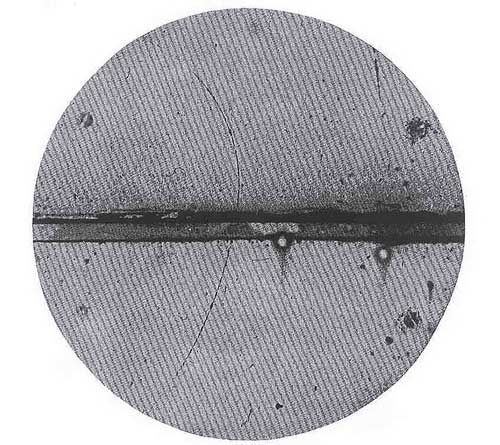The positron or antielectron is the antiparticle or the antimatter counterpart of the electron. The positron has an electric charge of +1e, a spin of 1⁄2, and the same mass as an electron. When a low-energy positron collides with a low-energy electron, annihilation occurs, resulting in the production of two or more gamma ray photons (see electron-positron annihilation). Positrons may be generated by positron emission radioactive decay (through weak interactions), or by pair production from a sufficiently energetic photon. History Theoretical foreshadowing and prediction In 1928, Paul Dirac published a paper[2] that suggested the possibility of an electron having both a positive charge and negative energy. This paper introduced the Dirac equation, a unification of quantum mechanics, special relativity, and the then-new concept of electron spin to explain the Zeeman effect. The paper did not explicitly predict a new particle, but did allow for electrons having either positive or negative energy as solutions. The positive-energy solution explained experimental results, but Dirac was puzzled by the equally valid negative-energy solution that the mathematical model allowed. Quantum mechanics did not allow the negative energy solution to simply be ignored, as classical mechanics often did in such equations; the dual solution implied the possibility of an electron spontaneously jumping between positive and negative energy states. However, no such transition had yet been observed experimentally. He referred to the issues raised by this conflict between theory and observation as "difficulties" that were "unresolved". Dirac wrote a follow-up paper in December 1929[3] that attempted to explain the unavoidable negative-energy solution for the relativistic electron. He argued that "... an electron with negative energy moves in an external [electromagnetic] field as though it carries a positive charge." He further asserted that all of space could be regarded as a "sea" of negative energy states that were filled, so as to prevent electrons jumping between positive energy states (negative electric charge) and negative energy states (positive charge). The paper also explored the possibility of the proton being an island in this sea, and that it might actually be a negative-energy electron. Dirac acknowledged that the proton having a much greater mass than the electron was a problem, but expressed "hope" that a future theory would resolve the issue. Robert Oppenheimer argued strongly against the proton being the negative-energy electron solution to Dirac's equation. He asserted that if it were, the hydrogen atom would rapidly self-destruct.[4] Persuaded by Oppenheimer's argument, Dirac published a paper in 1931 that predicted the existence of an as-yet unobserved particle that he called an "anti-electron" that would have the same mass as an electron and that would mutually annihilate upon contact with an electron.[5] Experimental clues and discovery
Cloud chamber photograph by C.D. Anderson of the first positron ever identified. A 6 mm lead plate separates the upper half of the chamber from the lower half. The positron must have come from below since the upper track is bent more strongly in the magnetic field indicating a lower energy. (*) Dmitri Skobeltsyn came close to discovering the positron in 1923.[6] While using a bubble chamber to try to detect gamma radiation in cosmic rays, Skobeltsyn detected particles that acted like electrons but curved in the opposite direction in an applied magnetic field. He was puzzled by these results, and shared them with other scientists, none of whom could explain them. Likewise, in 1929 Chung-Yao Chao, a graduate student at Caltech, noticed some anomalous results that indicated particles behaving like electrons, but with a positive charge, though the results were inconclusive and the phenomenon was not pursued.[7] Carl D. Anderson discovered the positron in 1932,[8] for which he won the Nobel Prize for Physics in 1936.[9] Anderson also coined the term positron. The positron was the first evidence of antimatter and was discovered when Anderson allowed cosmic rays to pass through a cloud chamber and a lead plate. A magnet surrounded this apparatus, causing particles to bend in different directions based on their electric charge. The ion trail left by each positron appeared on the photographic plate with a curvature matching the mass-to-charge ratio of an electron, but in a direction that proved its charge was positive. Anderson wrote in retrospect that the positron could have been discovered earlier based on Chung-Yao Chao's work, if only it had been followed up.[7] Production New research has dramatically increased the quantity of positrons that experimentalists can produce. Physicists at the Lawrence Livermore National Laboratory in California have used a short, ultra-intense laser to irradiate a millimetre-thick gold target and produce more than 100 billion positrons.[10][11] Applications Certain kinds of particle accelerator experiments involve colliding positrons and electrons at relativistic speeds. The high impact energy and the mutual annihilation of these matter/antimatter opposites create a fountain of diverse subatomic particles. Physicists study the results of these collisions to test theoretical predictions and to search for new kinds of particles. Positrons, created through the decay of a radioactive tracer, are detected in positron emission tomography (PET) scanners used in hospitals. PET scanners create detailed three-dimensional images of metabolic activity within the human body. An experimental tool called positron annihilation spectroscopy (PAS) is used in materials research to detect variations in density, or even voids, within a solid material. See also * Beta particle
1. ^ The fractional version's denominator is the inverse of the decimal value (along with its relative standard uncertainty of 4.2×10−10).
1. ^ a b c d The original source for CODATA is: Mohr, P.J.; Taylor, B.N.; Newell, D.B. (2006). "CODATA recommended values of the fundamental physical constants". Reviews of Modern Physics 80: 633–730. doi:10.1103/RevModPhys.80.633. 2. ^ P. A. M. Dirac. "On the quantum theory of the electron". http://positron.physik.uni-halle.de/panet/publications/papers/paper49.pdf.
* What is a Positron? (from the Frequently Asked Questions :: Center for Antimatter-Matter Studies)
Retrieved from "http://en.wikipedia.org/" |
|


